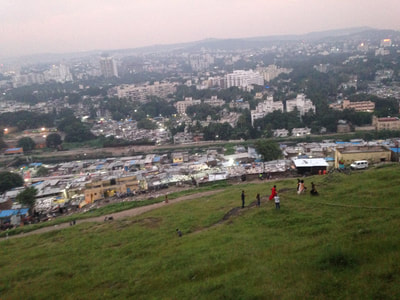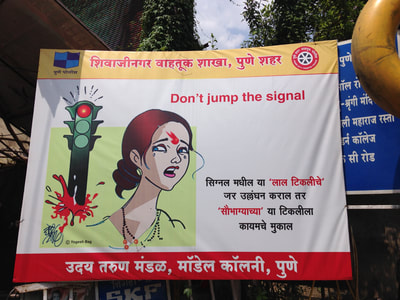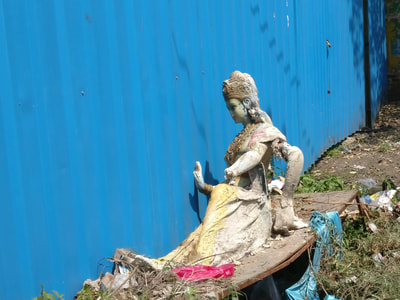|
So far, the worst part of Pune has been the quality of air. Like in all big cities of India, there is a lot of traffic on the streets and the vehicles are not being the best quality, the quality of the air is very poor. Before there is a bit of rain, smog becomes even more unbearable.
The other day I was doing pranayama (breathing exercises) and since all the windows of the institute are always open because of the heat, I could literally feel it in my nose when there was a three-wheeler or a motorbike or a very old bus that has just passed on the street. You feel the smell of exhaust fumes or LPG (liquefied petroleum gas) in tuc-tucs and buses in your throat, it leaves a bitter after-taste in the mouth and you can almost imagine the blackness that touches your lungs. Also instead of using air-conditioning (since it's very expensive), they have ceiling fans and other ventilators in the rooms and the practice hall as well. I don't mind that, I'm not a big fan of air-conditioning myself, the only problem is that the blades and metallic grids of these ventilators collect all the the dirt and dust in the air and than nicely spread it all over the place. No wonder that many of us already have a respiratory problem, running nose, coughing, sneezing. Just the more reason to practice more pranayama, isn't it?
1 Comment
This is my mantra for the whole month. And although it's easier said than done, it is quite surprising how after a group class of 120 minutes I still feel the urge to practice another two, two and a half hours on my own.
So far, the self-practice times have been the best. I felt a sort of ekagra (concentrated, one-pointed) state of mind, really focusing on the practice itself even if it's not really one-pointed because I do a variety of poses and I wouldn't deny looking around at the others what they are doing from time to time. And the heat also helps, I believe. Soaked in sweat, sticky everywhere but 35 degrees Celsius makes the body and joints more supple. Wonder if it's just an illusion or will my practice really change and ameliorate by the end of the month? In any case, that's the goal and I'll see to it that it happens. Needless to say that fruits here are wonderful. You just walk out into the street and on almost every corner you find fruit sellers or "phal wallah" offering their merchandise on their handcarts, using small, old-fashioned scales or simply selling fruits by the piece.
Apart from the not so exotic or now widespread fruits, such as melon, honeydew melon, bananas, apples, pears, pineapples, you have a huge variety of funny looking exotic fruits as well. Guava is either whitish-yellowish in colour, or pink, it is a bit smaller than a tennis ball and has tiny, hard but edible seeds on the inside. Its taste is fresh, slightly citrus like but different from all the fruits we usually find in Europe. Chikoo looks like round small potatoes from the outside with its earth-like colour and has hard, black seeds that can vary from one to four in number. Its texture is like that of pears with its tiny, stoney particles but the taste is more like that of medlar, deeply earthy with a bit of sweetness to it. Citrus fruits are also different, they call orange what we call mandarine and what tastes like orange are mosambi for them. (Would be sweet lemon for us, green on the outside and sweet and sour in taste.) They also do not have lemon, only lime but they consider it a vegetable as they use it mostly in cooking. Pomegranate is very deep in colour, smaller than the ones we find at home and it's so ripe that when squeezed like an orange, the pink seeds fall out from the skin by themselves. And then you have papaya which again is nothing like the ones you can buy in Europe. They are not so big and their skin can vary from green to yellow and orange in colour, and are so ripe and sweet that it almost melts in your month when you take a bite. (Interestingly the ones we have bought so far had none of the black, shiny seeds that you would find in a papaya normally.) The big surprise for me was custard apple which I thought I didn't like but tried again and it turned out that it's a delicious fruit. It looks so funny, like a bee-hive made up of small parts that start falling apart when the fruit is very ripe. On the inside, you have small, hard, black seeds, you have to suck the fruit off these seeds and there is a little more fruit on the inside of the skin. And it is by no chance that this fruit is called the custard apple as the texture is that of a pudding and it's very sweet in taste. And of course there are a lot of others we cannot eat at the moment because they are not is season but are just as delicious, such as physalis, litchi, passion fruit and my all-time favourite, mangoes. I guess I'll just have to come back again to eat them all. So finally, today I got to practice at the RIMYI for the first time in my life. Since I first had to register in the office, I missed the morning class and the first thing I got to do was a self-practice in the yoga hall. Each morning, from 9 to noon, you can go into the hall and do whatever you want to do, with all the props available but no guidance at all.
And I was thinking, what a huge responsibility this is! You are together with others, including the not so advanced practitioners as well as the "superstars" of Iyengar yoga. What are you going to make of your time? Are you going to start doing something and then peep over to the others and turn off your trail and do something like they are doing? Or do you have a previously prepared programme that you are going to follow, no matter what? Not considering your present state of mind and body? You are just preparing for an exam or experimenting with a pre-set sequence or something that has worked for you before? Although I'm used to practicing on my own, being at home and doing something that comes spontaneously or that I have worked out for myself is totally different. There you get up, check your emails or washing machine, whatever takes your mind off the path of yoga. But here, in this "temple", it is different. You have a set time for you, you need to make the most of it. Outside, it is 35 degrees, you hear the noises of the street (all the windows are open and the constant tooting of cars and three-wheelers create an asymmetric and yet music like noise) but inside, in spite of the noises created by the practitioners, you feel that there is a total silence, people looking inside and observing themselves from within, everybody doing something different and yet searching for something similar. It is a powerful and worthy experience. Traffic in India is like a video game... It's fun but you can easily loose lives. Whether you are a member of a family of six riding a motorbike (proud father in the front, wife behind, him holding his waist only with one hand as with the other, she is balancing a baby wrapped in a cloth and a hat even in thirty degrees, and all the other children, one, two or three behind the parents). Or else, you are trying to get from point A to B on foot. Now that is a challenge! For one thing, you have to put up with all the noise and smog of the city. But you also have to be brave, attentive and self-conscious. When crossing the street, whether you have green or red light, keep your breath calm, be conscious of all your body parts and their dimensions and be quick and determined. Just like when practicing yoga. But it is not better when you are walking on the sideway either. First of all, you are lucky if there is such a thing as a sidewalk and it's not blocked by all the vendors on the street. Then you have to watch out for holes in the pavement and iron rods sticking out from it. And finally if you managed to go along without falling or bumping into any of these street furniture, you can still lose points by accidentally kicking other things lying around on the ground whether it be a sleeping dog or a sleeping man. Or else, your attention can be distracted by a discarded paper-machier god or goddess left over from a previous celebration, looking sideways, feeling aggrieved that he is no longer so important. The devotees now go to the other little shrines, where they can open the glass doors, place an incense stick in front of the colourful, elephant headed Ganesh or any other popular figure of the pantheon of Hindu gods. Keep going, if practice a lot, maybe soon you can go to level two but if you don't stick to the rules, easily it can be GAME OVER. |
AuthorMy month in Pune, India Archives
November 2017
Categories |




 RSS Feed
RSS Feed
